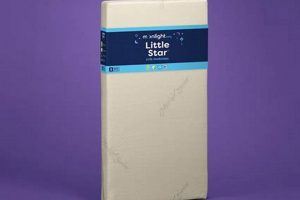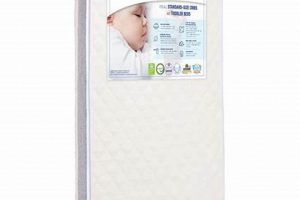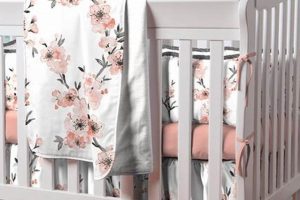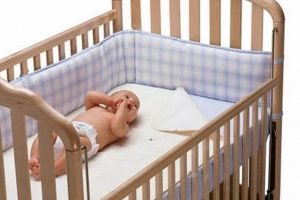A sleeping surface specifically designed for infant and toddler safety within a contained sleeping structure is fundamental to early childhood development. It comprises a support system, usually metal or wood, surrounding a cushioned pad tailored to fit snugly. The intended purpose is to provide a secure and comfortable area for newborns and young children to rest and sleep, minimizing the risk of falls or entrapment.
The presence of a safe and supportive sleeping environment is a primary concern for caregivers. Historically, various materials and designs have been employed, evolving over time to prioritize safety standards and ergonomic considerations. A properly designed sleeping arrangement promotes healthy sleep patterns, which are crucial for cognitive and physical growth during early developmental stages. Furthermore, it offers peace of mind to parents and guardians, knowing their child is resting in a secure space.
The following sections will delve into the construction materials commonly used, relevant safety regulations, considerations for selecting appropriate sizes and firmness levels, and best practices for maintaining a clean and hygienic sleeping environment. Furthermore, differing types and their respective advantages will be evaluated, providing a thorough overview for informed purchasing decisions.
Guidance for Optimal Selection and Use
The following recommendations are intended to provide essential information for choosing and utilizing a safe and effective sleeping arrangement for infants and toddlers.
Tip 1: Adhere to Safety Standards: Prioritize products that meet or exceed safety certifications established by regulatory bodies. These certifications ensure rigorous testing for potential hazards like suffocation or entrapment.
Tip 2: Ensure Proper Fit: The sleeping pad must fit snugly within the surrounding structure. Gaps exceeding two finger widths between the perimeter of the sleeping pad and the interior frame are unacceptable and pose a safety risk.
Tip 3: Select Appropriate Firmness: An adequately firm sleeping surface is essential to reduce the risk of Sudden Infant Death Syndrome (SIDS). Overly soft surfaces can conform to the infant’s face, potentially obstructing breathing.
Tip 4: Maintain a Clean Sleeping Environment: Regularly clean the sleeping surface and surrounding structure with non-toxic cleaning agents. This minimizes the buildup of allergens and bacteria.
Tip 5: Inspect for Damage: Routinely inspect the sleeping surface and support structure for signs of wear, tear, or damage. Replace any components that exhibit compromised integrity.
Tip 6: Avoid Additional Bedding: Refrain from placing loose blankets, pillows, or toys within the sleeping area. These items can increase the risk of suffocation.
Tip 7: Follow Manufacturer’s Instructions: Always adhere to the manufacturer’s guidelines for assembly, use, and maintenance. Deviating from these instructions can compromise the product’s safety and effectiveness.
By implementing these guidelines, caregivers can significantly enhance the safety and well-being of infants and toddlers during sleep, promoting healthy development and minimizing potential hazards.
The subsequent sections will address specific product types and materials in greater detail, providing a comprehensive overview for informed decision-making.
1. Firmness Standards
Firmness standards for sleeping surfaces designed for infants represent a cornerstone in preventing Sudden Infant Death Syndrome (SIDS) and promoting safe sleep practices. These standards aim to mitigate risks associated with soft surfaces that can conform to an infant’s face, potentially obstructing breathing. Adherence to established firmness guidelines is paramount when selecting a “bed crib mattress”.
- Regulatory Guidelines
Organizations such as the Consumer Product Safety Commission (CPSC) and ASTM International have established specific firmness requirements. These guidelines often involve indentation load deflection (ILD) tests, which measure the force required to compress the sleeping surface by a certain amount. A higher ILD value indicates a firmer surface.
- Material Composition and Firmness
The materials used in the construction of a “bed crib mattress” directly impact its firmness. Polyurethane foam, in varying densities, is commonly employed. Higher-density foams generally result in firmer sleeping surfaces that better comply with safety standards.
- Testing and Certification
Reputable manufacturers subject their products to rigorous testing by independent laboratories to verify compliance with established firmness standards. Certifications from organizations like Greenguard Gold or CertiPUR-US, while not solely focused on firmness, often indicate that the materials have undergone testing to ensure safety and performance characteristics.
- Clinical Relevance
Medical and pediatric organizations, such as the American Academy of Pediatrics, advocate for firm sleeping surfaces. This recommendation is based on extensive research demonstrating a correlation between soft sleeping surfaces and an increased risk of SIDS. Consequently, ensuring that a “bed crib mattress” meets firmness standards aligns with established medical best practices.
The interconnectedness of regulatory guidelines, material composition, independent testing, and clinical recommendations underscores the critical importance of firmness standards in the selection of a “bed crib mattress”. A commitment to adhering to these standards is a fundamental aspect of ensuring infant safety and promoting healthy sleep practices.
2. Material Safety
The selection of materials utilized in the construction of a “bed crib mattress” bears a direct causal relationship with infant health and well-being. The importance of material safety stems from the prolonged exposure infants have to these surfaces, increasing the potential for absorption of harmful chemicals. For instance, mattresses constructed with polyvinyl chloride (PVC) may off-gas volatile organic compounds (VOCs), which have been linked to respiratory irritation and other adverse health effects in susceptible individuals. Consequently, prioritizing material safety is an indispensable component in the manufacturing and selection process of a sleeping surface intended for infant use.
Furthermore, the practical significance of understanding material composition extends to informed consumer decision-making. Real-life examples demonstrate instances where inadequate material safety standards resulted in product recalls due to excessive levels of phthalates, flame retardants, or other hazardous substances. By focusing on products that are certified by independent organizations such as Greenguard or Oeko-Tex, consumers can mitigate the risk of exposing their infants to potentially harmful chemicals. Moreover, a growing awareness of sustainable and non-toxic material options, such as organic cotton or natural latex, provides alternatives that align with both safety and environmental consciousness.
In conclusion, the material safety of a “bed crib mattress” presents a significant and ongoing challenge within the realm of infant care. The industry continues to evolve with innovative materials and manufacturing processes aimed at enhancing product safety and minimizing environmental impact. By maintaining a rigorous focus on research, testing, and certification, manufacturers and consumers can collectively contribute to ensuring a safer and healthier sleep environment for infants and young children. The selection process should encompass a holistic evaluation of material composition, certifications, and potential health implications to effectively safeguard infant well-being.
3. Proper Fit
The dimensional compatibility between a “bed crib mattress” and its corresponding support structure is a critical determinant of infant safety. A precise fit minimizes the risk of entrapment and potential suffocation hazards, aligning with established safety standards for infant sleep environments.
- Gap Mitigation
Excessive spacing between the perimeter of the “bed crib mattress” and the crib frame constitutes a significant safety concern. Regulatory guidelines stipulate maximum allowable gaps, typically no more than two finger widths. Such gaps can create opportunities for infant limbs or extremities to become lodged, leading to potential injury or suffocation.
- Dimensional Tolerances
Variations in crib dimensions across manufacturers necessitate adherence to standardized “bed crib mattress” sizes. Slight deviations can compromise the integrity of the fit, potentially leading to hazardous conditions. Consistent monitoring of dimensional tolerances during manufacturing is therefore essential.
- Long-Term Use Considerations
Extended use of a “bed crib mattress” can result in material compression or deformation, potentially altering its original dimensions. Regular inspection for any signs of size alteration is crucial. Replacement may be necessary if the fit becomes compromised over time.
- Impact on Bedding
An improperly fitted “bed crib mattress” can impact the performance of fitted sheets and other bedding accessories. Ill-fitting sheets may become dislodged, creating a loose bedding hazard that contradicts safe sleep recommendations. Proper fit ensures secure bedding and minimizes this risk.
The interplay of gap mitigation, dimensional tolerances, long-term use considerations, and the impact on bedding underscores the multi-faceted significance of achieving proper fit. Prioritizing dimensional compatibility between the “bed crib mattress” and crib frame is an essential element in fostering a safe and secure sleep environment for infants, reducing the risk of potential hazards and promoting overall well-being. The proper maintenance of this fit is crucial.
4. Breathability
Breathability, in the context of a “bed crib mattress”, directly influences an infant’s thermoregulation and reduces the risk of overheating, a known factor contributing to Sudden Infant Death Syndrome (SIDS). The causal mechanism involves facilitating airflow through the mattress core and surface, allowing for the dissipation of body heat and moisture. A mattress lacking breathability traps heat, elevating the infant’s core temperature, which disrupts sleep patterns and increases physiological stress. For instance, a study published in the Journal of Pediatrics found that infants sleeping on non-breathable mattresses exhibited higher skin temperatures and increased sweating compared to those on breathable surfaces.
The practical significance of understanding breathability translates to informed consumer choices. Mattresses constructed with open-cell foam, natural fibers like cotton or wool, or featuring specialized ventilation channels promote enhanced airflow. Conversely, mattresses encased in impermeable materials, such as vinyl, restrict breathability, potentially creating a less safe sleeping environment. Furthermore, the use of breathable mattress protectors and sheets complements the mattress’s inherent breathability, maximizing its effectiveness in regulating temperature and reducing moisture accumulation, which can also contribute to the growth of mold and bacteria.
In summary, the breathability of a “bed crib mattress” is an indispensable component of a safe and healthy sleep environment. It directly impacts an infant’s physiological well-being by regulating temperature and minimizing the risk of overheating. While challenges remain in standardizing breathability testing and labeling, ongoing research and product innovation are driving improvements in mattress design and material selection. Prioritizing breathability in the selection of a “bed crib mattress” reflects a commitment to evidence-based practices and promotes optimal infant health.
5. Hygiene
The maintenance of cleanliness within a “bed crib mattress” environment directly influences infant health and well-being. The sleeping surface, due to its prolonged and intimate contact with the infant, serves as a potential reservoir for microorganisms, allergens, and bodily fluids. The proliferation of these contaminants can trigger allergic reactions, respiratory distress, or skin irritations. A direct causal relationship exists between the level of hygiene and the prevalence of such adverse health outcomes.
The practical implications of understanding this connection necessitate regular and thorough cleaning protocols. For instance, spills of formula or bodily fluids should be addressed immediately using appropriate cleaning agents that are both effective in sanitizing the surface and safe for infant exposure. Furthermore, the periodic cleaning of the entire “bed crib mattress,” including its cover and core (if accessible), mitigates the accumulation of dust mites, mold, and other allergens. Real-world examples demonstrate instances where neglect of proper hygiene within sleeping environments has led to outbreaks of skin infections or exacerbated pre-existing respiratory conditions in infants. A clean “bed crib mattress” is important.
In conclusion, the hygienic state of a “bed crib mattress” is a critical, yet often overlooked, aspect of infant care. The implementation of consistent and effective cleaning practices significantly reduces the risk of adverse health outcomes. While challenges persist in developing standardized cleaning protocols and educating caregivers on best practices, ongoing efforts to improve mattress design and material selection, coupled with heightened awareness, contribute to creating a healthier sleeping environment for infants and young children. The continuous maintenance of the “bed crib mattress” is vital to child care.
Frequently Asked Questions About Bed Crib Mattresses
This section addresses common inquiries and clarifies misconceptions regarding bed crib mattresses, focusing on safety, selection, and maintenance.
Question 1: What constitutes a safe firmness level for a bed crib mattress?
A safe bed crib mattress exhibits sufficient firmness to prevent indentation under the infant’s weight. An overly soft surface may conform to the infant’s face, posing a suffocation risk. Regulatory bodies provide guidelines for acceptable firmness levels, often measured through indentation load deflection tests. Consult product specifications and independent testing reports to verify compliance.
Question 2: How often should a bed crib mattress be replaced?
The lifespan of a bed crib mattress depends on material quality, usage intensity, and maintenance practices. However, it’s advisable to replace the mattress if it exhibits signs of wear and tear, such as sagging, deformation, or compromised structural integrity. A used mattress may harbor allergens or microorganisms, even after cleaning, which could impact infant health.
Question 3: What are the potential health hazards associated with flame retardant chemicals in bed crib mattresses?
Some flame retardant chemicals previously used in bed crib mattresses have been linked to adverse health effects, including endocrine disruption and neurodevelopmental issues. Newer regulations often restrict the use of these chemicals. Look for certifications indicating compliance with relevant safety standards and transparency regarding material composition.
Question 4: How can parents minimize the risk of Sudden Infant Death Syndrome (SIDS) when using a bed crib mattress?
To minimize the risk of SIDS, adhere to established safe sleep guidelines. Place the infant on their back to sleep on a firm, flat surface, devoid of loose bedding, pillows, or toys. Ensure the bed crib mattress fits snugly within the crib frame to prevent entrapment. Maintain a smoke-free environment and consider using a breathable mattress cover.
Question 5: What materials are considered safe and non-toxic for bed crib mattresses?
Materials such as organic cotton, natural latex, and certain types of polyurethane foam certified as low-VOC emissions are generally considered safer options for bed crib mattresses. Avoid mattresses containing PVC, phthalates, or heavy metals. Always verify product certifications and material disclosures.
Question 6: How should a bed crib mattress be cleaned and maintained?
Regularly clean the bed crib mattress surface with a mild, non-toxic cleaning solution. Address spills promptly to prevent staining and microbial growth. A waterproof mattress protector can provide an additional barrier against fluids. Air out the mattress periodically to promote ventilation and reduce moisture accumulation.
Prioritizing safety, adhering to established guidelines, and making informed purchasing decisions are crucial for ensuring a secure and healthy sleep environment for infants.
The subsequent section will provide detailed guidance on choosing the optimal bed crib mattress based on individual needs and preferences.
Conclusion
The preceding exploration of the “bed crib mattress” has illuminated its multifaceted role in infant safety and development. Key areas of focus included firmness standards, material safety, proper fit, breathability, and hygiene, each demonstrably impacting infant well-being. Adherence to established safety guidelines, informed material selection, and diligent maintenance practices are essential for creating a secure sleep environment. It’s also been established that there are many options available to select for a safe bed crib mattress.
Ultimately, the responsibility for ensuring infant safety rests upon informed caregivers. Continued vigilance, coupled with ongoing advancements in product design and regulatory oversight, are necessary to mitigate potential hazards and promote healthy sleep outcomes. Future research and innovation should focus on developing even safer, more sustainable, and more effective sleeping surfaces for infants, reflecting a collective commitment to prioritizing their well-being.


![Best Avocado Crib Mattress [Guide] for Baby Sleep! Organic & Natural Mattress Buyer’s Guide: Non-Toxic Sleep Solutions Best Avocado Crib Mattress [Guide] for Baby Sleep! | Organic & Natural Mattress Buyer’s Guide: Non-Toxic Sleep Solutions](https://mattressworldpa.com/wp-content/uploads/2025/07/th-1255-300x200.jpg)




